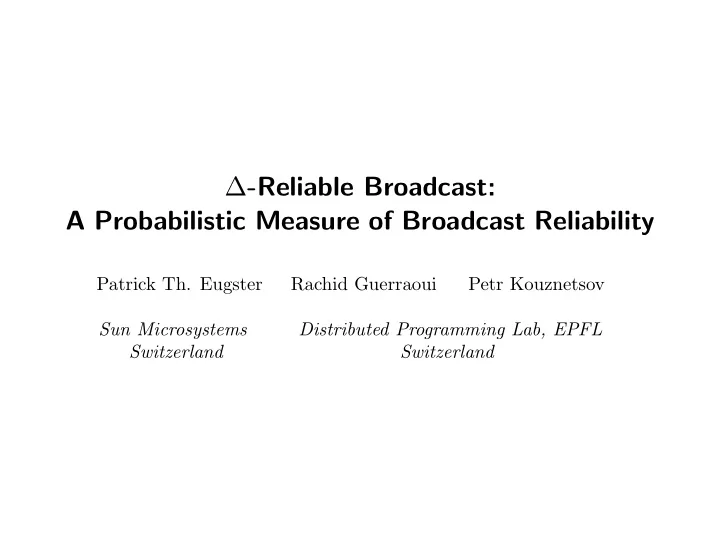

∆ -Reliable Broadcast: A Probabilistic Measure of Broadcast Reliability Patrick Th. Eugster Rachid Guerraoui Petr Kouznetsov Sun Microsystems Distributed Programming Lab, EPFL Switzerland Switzerland
ICDCS 2004 2/15 Outline 1. The problem: scalable “reliable” broadcast 2. Reliable Broadcast specification [HT94]. 3. ∆-Reliable Broadcast. 4. Reliability distribution function. 5. Examples: reliability analysis of Bimodal Multicast [BHO + 99] and IP Multicast [DC90].
ICDCS 2004 3/15 Broadcast protocols • Best-effort: Multicast Usenet (MUSE), IP Multicast, Reliable Multicast Transfer Protocol (RMTP), etc. • Probabilistic: Bimodal Multicast, lpbcast, etc. What is the problem?
ICDCS 2004 4/15 Traditional specification: Reliable Broadcast[HT94] For any message m , every process delivers m Integrity. at most once, and only if m was previously broadcast by sender(m). If a correct process p broadcasts a message m , Validity. then p eventually delivers m . Agreement. If a correct process delivers a message m , then every correct process eventually delivers m .
ICDCS 2004 5/15 Informal specification: Atomicity [BHO + 99] A broadcast protocol provides a bimodal delivery guarantee if there is • a high probability that a broadcast message will reach almost all processes, • a low probability that a broadcast message will reach just a very small set of processes, and • a vanishingly small probability that a broadcast message will reach some intermediate number of processes.
ICDCS 2004 6/15 Bridging the gap: ∆ -Reliable Broadcast Let ∆ = ( ψ, ρ ) ∈ [0 , 1] × [0 , 1]. A broadcast protocol is ∆ -Reliable iff the following properties are simultaneously satisfied with probability ψ : Integrity. For any message m , every process delivers m at most once, and only if m was previously broadcast by sender ( m ). Validity. If a correct process p broadcasts a message m then p eventually delivers m . ∆ -Agreement. If a correct process delivers a message m , then eventually at least a fraction ρ of correct processes deliver m .
ICDCS 2004 7/15 ∆ -Reliable Broadcast: ρ and ψ ∆ = ( ψ, ρ ) is a “reliability measure” of a given protocol. Reliability degree ρ : the fraction of correct processes that eventually deliver a broadcast message. Reliability probability ψ : - the probability that “enough” (correct) processes deliver a broadcast message and no fake or duplicate messages are delivered.
ICDCS 2004 8/15 Reliability distribution function Ψ Let E be an environment space and B be 1 a broadcast protocol. Ψ B 1 ( ρ, E ) A function ψ B : [0 , 1] × E [0 , 1] �→ Ψ B 2 ( ρ, E ) is the reliability distribution function of B iff ∀ ρ ∈ [0 , 1] ∀E ∈ E : 0 ρ 1 B is ∆-Reliable with ∆ = ( ψ B ( ρ, E ) , ρ ). B 1 is more reliable than B 2 in E .
ICDCS 2004 9/15 Reliability distribution function: examples • Dreamcast (Reliable Broadcast [HT94]) in a given E ∈ E : ∀ ρ ∈ [0 , 1] : ψ ( ρ, E ) = 1 . • Spellcast (does nothing): ∀ ρ ∈ ]0 , 1] , ∀E ∈ E : ψ ( ρ, E ) = 0 .
ICDCS 2004 10/15 Atomicity Atomicity predicate of Bimodal Multicast: given a protocol B , σ ∈ [0 , 0 . 5] and an environment E ∈ E , a broadcast message reaches more than a fraction σ , but less than a fraction 1 − σ of correct processes with probability: P ( σ ≤ ρ < 1 − σ ) = ψ B ( σ, E ) − ψ B (1 − σ, E )
ICDCS 2004 11/15 Bimodal Multicast [BHO + 99] Environment: deliver and gossip ( m , round) { * Auxiliary function * } n processes if received already( m ) then return Fanout β bmdeliver( m ) Message loss probability ε if round= T then return Process crash probability τ choose S ⊂ Π , such that | S | = nβ Number of gossip rounds T for each p in S send to p gossip ( m ,round+1) On bmcast ( m ): deliver and gossip ( m ,0) On receive gossip( m ,round): deliver and gossip ( m ,round)
ICDCS 2004 12/15 IP Multicast (PIM-SM) [DC90, FHHK00] Broadcast source Environment: k -ary spanning tree of depth d k d processes Message loss probability ε l Process crash probability τ Router crash probability γ k d broadcast destinations
ICDCS 2004 13/15 Reliability distribution functions Bimodal Multicast IP Multicast 1 0.8 probability 0.6 0.4 0.2 0 0 0.2 0.4 0.6 0.8 1 reliability degree
ICDCS 2004 14/15 Average reliability degrees Bimodal Multicast IP Multicast 1 expected reliability degree 0.95 0.9 0.85 0.8 0.75 0.7 0 500 1000 1500 2000 2500 3000 3500 4000 4500 5000 n
ICDCS 2004 15/15 Outline 1. The problem: scalable “reliable” broadcast 2. Reliable Broadcast specification [HT94]. 3. ∆-Reliable Broadcast. 4. Reliability distribution function. 5. Examples: reliability analysis of Bimodal Multicast [BHO + 99] and IP Multicast [DC90].
References [BHO + 99] Kenneth P. Birman, Mark Hayden, Oznur Ozkasap, Zhen Xiao, Mihai Budiu, and Yaron Minsky. Bimodal multicast. ACM Transactions on Computer Systems , 17(2):41–88, 1999. [DC90] S. Deering and D. Cheriton. Multicast Routing in Datagram Internetworks and Extendexd LANs. ACM Transactions on Computer Systems , 8(2):85–110, May 1990. [FHHK00] B. Fenner, M. Handley, H. Holbrook, and I. Kouvelas. Protocol Independent Multicast-Sparse Mode (PIM-SM):
Protocol Specification (Revised). Internet Engineering Task Force (IETF) , November 2000. [HT94] Vassos Hadzilacos and Sam Toueg. A modular approach to fault-tolerant broadcast and related problems. Technical report, Cornell University, Computer Science, May 1994.
Recommend
More recommend